drain bolt FORD SIERRA 1992 2.G Cooling And Air Conditioning Systems Workshop Manual
[x] Cancel search | Manufacturer: FORD, Model Year: 1992, Model line: SIERRA, Model: FORD SIERRA 1992 2.GPages: 12, PDF Size: 0.62 MB
Page 3 of 12
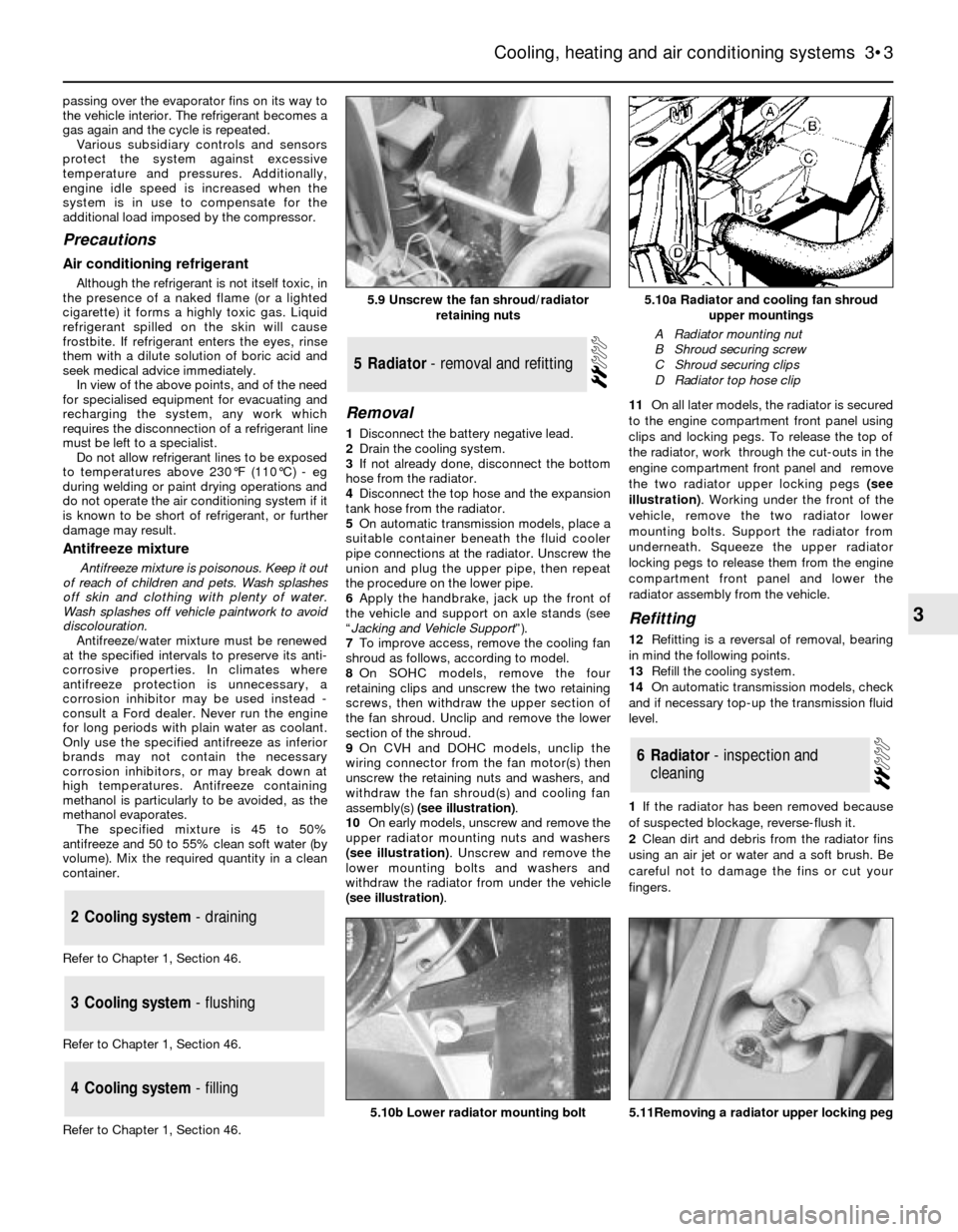
passing over the evaporator fins on its way to
the vehicle interior. The refrigerant becomes a
gas again and the cycle is repeated.
Various subsidiary controls and sensors
protect the system against excessive
temperature and pressures. Additionally,
engine idle speed is increased when the
system is in use to compensate for the
additional load imposed by the compressor.
Precautions
Air conditioning refrigerant
Although the refrigerant is not itself toxic, in
the presence of a naked flame (or a lighted
cigarette) it forms a highly toxic gas. Liquid
refrigerant spilled on the skin will cause
frostbite. If refrigerant enters the eyes, rinse
them with a dilute solution of boric acid and
seek medical advice immediately.
In view of the above points, and of the need
for specialised equipment for evacuating and
recharging the system, any work which
requires the disconnection of a refrigerant line
must be left to a specialist.
Do not allow refrigerant lines to be exposed
to temperatures above 230°F (110°C) - eg
during welding or paint drying operations and
do not operate the air conditioning system if it
is known to be short of refrigerant, or further
damage may result.
Antifreeze mixture
Antifreeze mixture is poisonous. Keep it out
of reach of children and pets. Wash splashes
off skin and clothing with plenty of water.
Wash splashes off vehicle paintwork to avoid
discolouration.
Antifreeze/water mixture must be renewed
at the specified intervals to preserve its anti-
corrosive properties. In climates where
antifreeze protection is unnecessary, a
corrosion inhibitor may be used instead -
consult a Ford dealer. Never run the engine
for long periods with plain water as coolant.
Only use the specified antifreeze as inferior
brands may not contain the necessary
corrosion inhibitors, or may break down at
high temperatures. Antifreeze containing
methanol is particularly to be avoided, as the
methanol evaporates.
The specified mixture is 45 to 50%
antifreeze and 50 to 55% clean soft water (by
volume). Mix the required quantity in a clean
container.
Refer to Chapter 1, Section 46.
Refer to Chapter 1, Section 46.
Refer to Chapter 1, Section 46.
Removal
1Disconnect the battery negative lead.
2Drain the cooling system.
3If not already done, disconnect the bottom
hose from the radiator.
4Disconnect the top hose and the expansion
tank hose from the radiator.
5On automatic transmission models, place a
suitable container beneath the fluid cooler
pipe connections at the radiator. Unscrew the
union and plug the upper pipe, then repeat
the procedure on the lower pipe.
6Apply the handbrake, jack up the front of
the vehicle and support on axle stands (see
“Jacking and Vehicle Support”).
7To improve access, remove the cooling fan
shroud as follows, according to model.
8On SOHC models, remove the four
retaining clips and unscrew the two retaining
screws, then withdraw the upper section of
the fan shroud. Unclip and remove the lower
section of the shroud.
9On CVH and DOHC models, unclip the
wiring connector from the fan motor(s) then
unscrew the retaining nuts and washers, and
withdraw the fan shroud(s) and cooling fan
assembly(s) (see illustration).
10On early models, unscrew and remove the
upper radiator mounting nuts and washers
(see illustration). Unscrew and remove the
lower mounting bolts and washers and
withdraw the radiator from under the vehicle
(see illustration).11On all later models, the radiator is secured
to the engine compartment front panel using
clips and locking pegs. To release the top of
the radiator, work through the cut-outs in the
engine compartment front panel and remove
the two radiator upper locking pegs (see
illustration). Working under the front of the
vehicle, remove the two radiator lower
mounting bolts. Support the radiator from
underneath. Squeeze the upper radiator
locking pegs to release them from the engine
compartment front panel and lower the
radiator assembly from the vehicle.
Refitting
12Refitting is a reversal of removal, bearing
in mind the following points.
13Refill the cooling system.
14On automatic transmission models, check
and if necessary top-up the transmission fluid
level.
1If the radiator has been removed because
of suspected blockage, reverse-flush it.
2Clean dirt and debris from the radiator fins
using an air jet or water and a soft brush. Be
careful not to damage the fins or cut your
fingers.
6Radiator -inspectionand
cleaning
5Radiator - removal and refitting
4Cooling system - filling
3Cooling system - flushing
2Cooling system - draining
Cooling, heating and air conditioning systems 3•3
3
5.10a Radiator and cooling fan shroud
upper mountings
A Radiator mounting nut
B Shroud securing screw
C Shroud securing clips
D Radiator top hose clip
5.11Removing a radiator upper locking peg5.10b Lower radiator mounting bolt
5.9 Unscrew the fan shroud/radiator
retaining nuts
Page 4 of 12
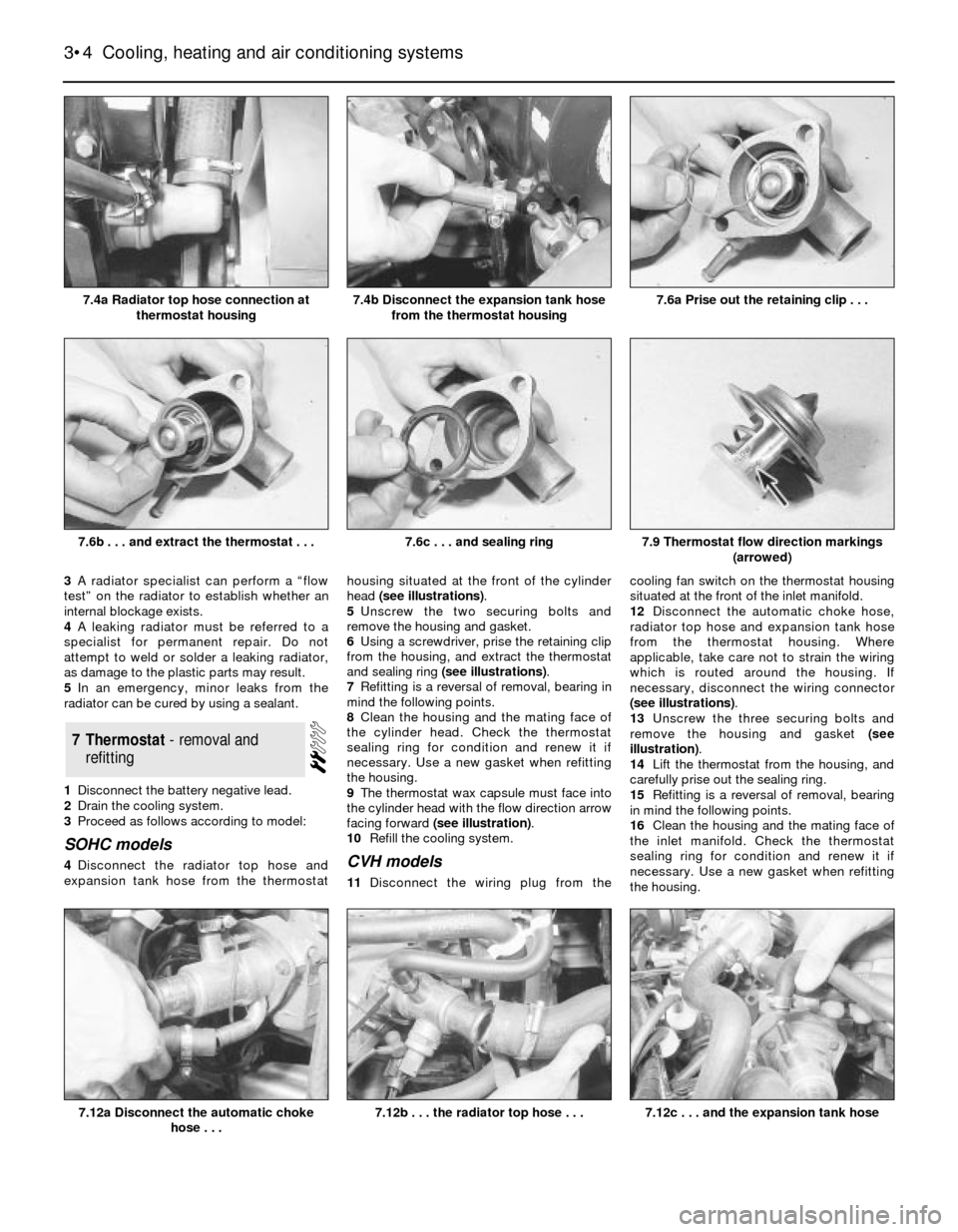
3A radiator specialist can perform a “flow
test” on the radiator to establish whether an
internal blockage exists.
4A leaking radiator must be referred to a
specialist for permanent repair. Do not
attempt to weld or solder a leaking radiator,
as damage to the plastic parts may result.
5In an emergency, minor leaks from the
radiator can be cured by using a sealant.
1Disconnect the battery negative lead.
2Drain the cooling system.
3Proceed as follows according to model:
SOHC models
4Disconnect the radiator top hose and
expansion tank hose from the thermostathousing situated at the front of the cylinder
head (see illustrations).
5Unscrew the two securing bolts and
remove the housing and gasket.
6Using a screwdriver, prise the retaining clip
from the housing, and extract the thermostat
and sealing ring (see illustrations).
7Refitting is a reversal of removal, bearing in
mind the following points.
8Clean the housing and the mating face of
the cylinder head. Check the thermostat
sealing ring for condition and renew it if
necessary. Use a new gasket when refitting
the housing.
9The thermostat wax capsule must face into
the cylinder head with the flow direction arrow
facing forward (see illustration).
10Refill the cooling system.CVH models
11Disconnect the wiring plug from thecooling fan switch on the thermostat housing
situated at the front of the inlet manifold.
12Disconnect the automatic choke hose,
radiator top hose and expansion tank hose
from the thermostat housing. Where
applicable, take care not to strain the wiring
which is routed around the housing. If
necessary, disconnect the wiring connector
(see illustrations).
13Unscrew the three securing bolts and
remove the housing and gasket (see
illustration).
14Lift the thermostat from the housing, and
carefully prise out the sealing ring.
15Refitting is a reversal of removal, bearing
in mind the following points.
16Clean the housing and the mating face of
the inlet manifold. Check the thermostat
sealing ring for condition and renew it if
necessary. Use a new gasket when refitting
the housing.
7Thermostat -removaland
refitting
3•4Cooling, heating and air conditioning systems
7.4a Radiator top hose connection at
thermostat housing7.6a Prise out the retaining clip . . .
7.12c . . . and the expansion tank hose7.12b . . . the radiator top hose . . .7.12a Disconnect the automatic choke
hose . . .
7.4b Disconnect the expansion tank hose
from the thermostat housing
7.6b . . . and extract the thermostat . . .7.9 Thermostat flow direction markings
(arrowed)7.6c . . . and sealing ring
Page 5 of 12
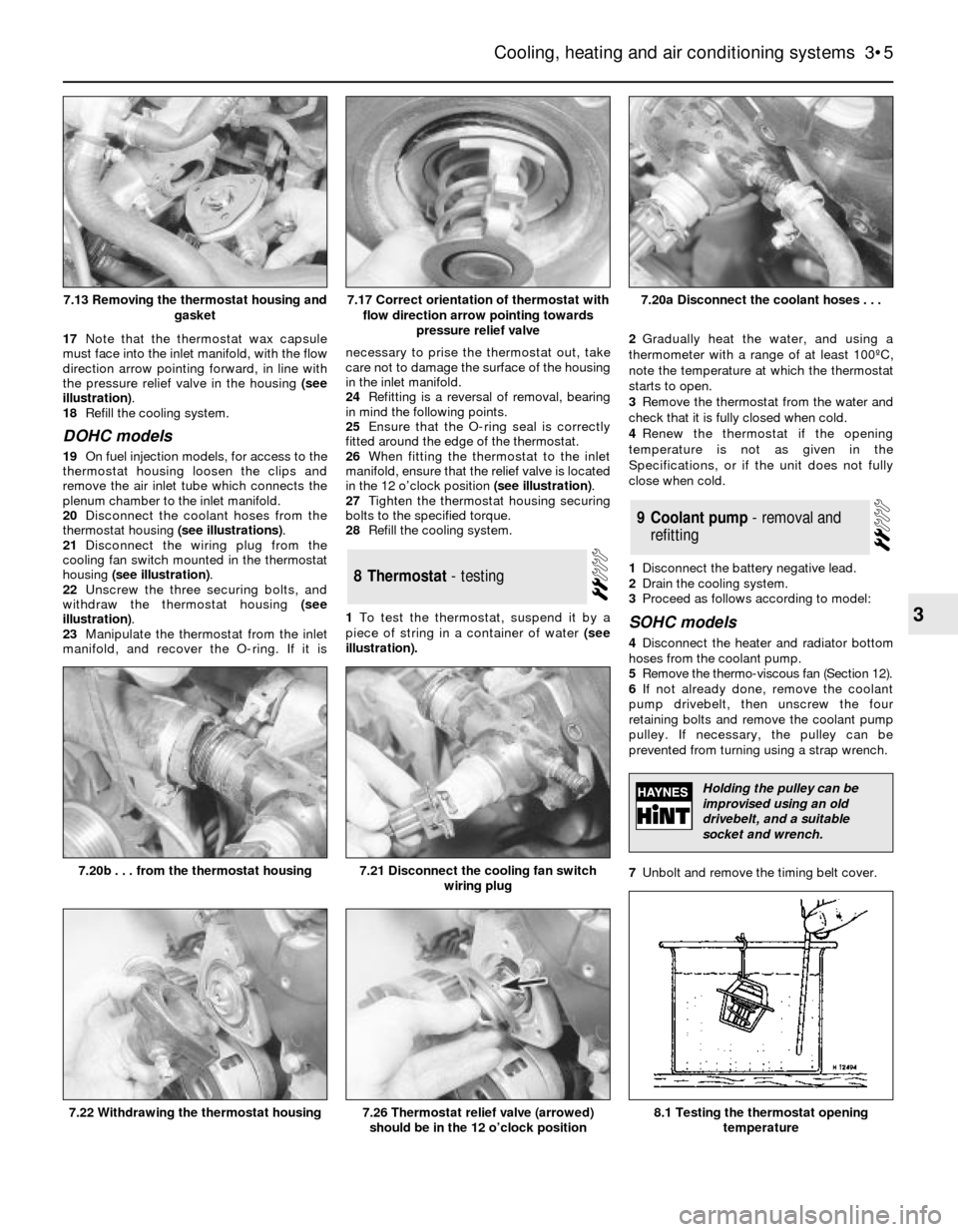
17Note that the thermostat wax capsule
must face into the inlet manifold, with the flow
direction arrow pointing forward, in line with
the pressure relief valve in the housing (see
illustration).
18Refill the cooling system.
DOHC models
19On fuel injection models, for access to the
thermostat housing loosen the clips and
remove the air inlet tube which connects the
plenum chamber to the inlet manifold.
20Disconnect the coolant hoses from the
thermostat housing (see illustrations).
21Disconnect the wiring plug from the
cooling fan switch mounted in the thermostat
housing (see illustration).
22Unscrew the three securing bolts, and
withdraw the thermostat housing (see
illustration).
23Manipulate the thermostat from the inlet
manifold, and recover the O-ring. If it isnecessary to prise the thermostat out, take
care not to damage the surface of the housing
in the inlet manifold.
24Refitting is a reversal of removal, bearing
in mind the following points.
25Ensure that the O-ring seal is correctly
fitted around the edge of the thermostat.
26When fitting the thermostat to the inlet
manifold, ensure that the relief valve is located
in the 12 o’clock position (see illustration).
27Tighten the thermostat housing securing
bolts to the specified torque.
28Refill the cooling system.
1To test the thermostat, suspend it by a
piece of string in a container of water (see
illustration).2Gradually heat the water, and using a
thermometer with a range of at least 100ºC,
note the temperature at which the thermostat
starts to open.
3Remove the thermostat from the water and
check that it is fully closed when cold.
4Renew the thermostat if the opening
temperature is not as given in the
Specifications, or if the unit does not fully
close when cold.
1Disconnect the battery negative lead.
2Drain the cooling system.
3Proceed as follows according to model:
SOHC models
4Disconnect the heater and radiator bottom
hoses from the coolant pump.
5Remove the thermo-viscous fan (Section 12).
6If not already done, remove the coolant
pump drivebelt, then unscrew the four
retaining bolts and remove the coolant pump
pulley. If necessary, the pulley can be
prevented from turning using a strap wrench.
7Unbolt and remove the timing belt cover.
9Coolant pump - removal and
refitting
8Thermostat - testing
Cooling, heating and air conditioning systems 3•5
3
7.20a Disconnect the coolant hoses . . .
8.1 Testing the thermostat opening
temperature7.26 Thermostat relief valve (arrowed)
should be in the 12 o’clock position7.22 Withdrawing the thermostat housing
7.21 Disconnect the cooling fan switch
wiring plug7.20b . . . from the thermostat housing
7.17 Correct orientation of thermostat with
flow direction arrow pointing towards
pressure relief valve7.13 Removing the thermostat housing and
gasket
Holding the pulley can be
improvised using an old
drivebelt, and a suitable
socket and wrench.
Page 8 of 12
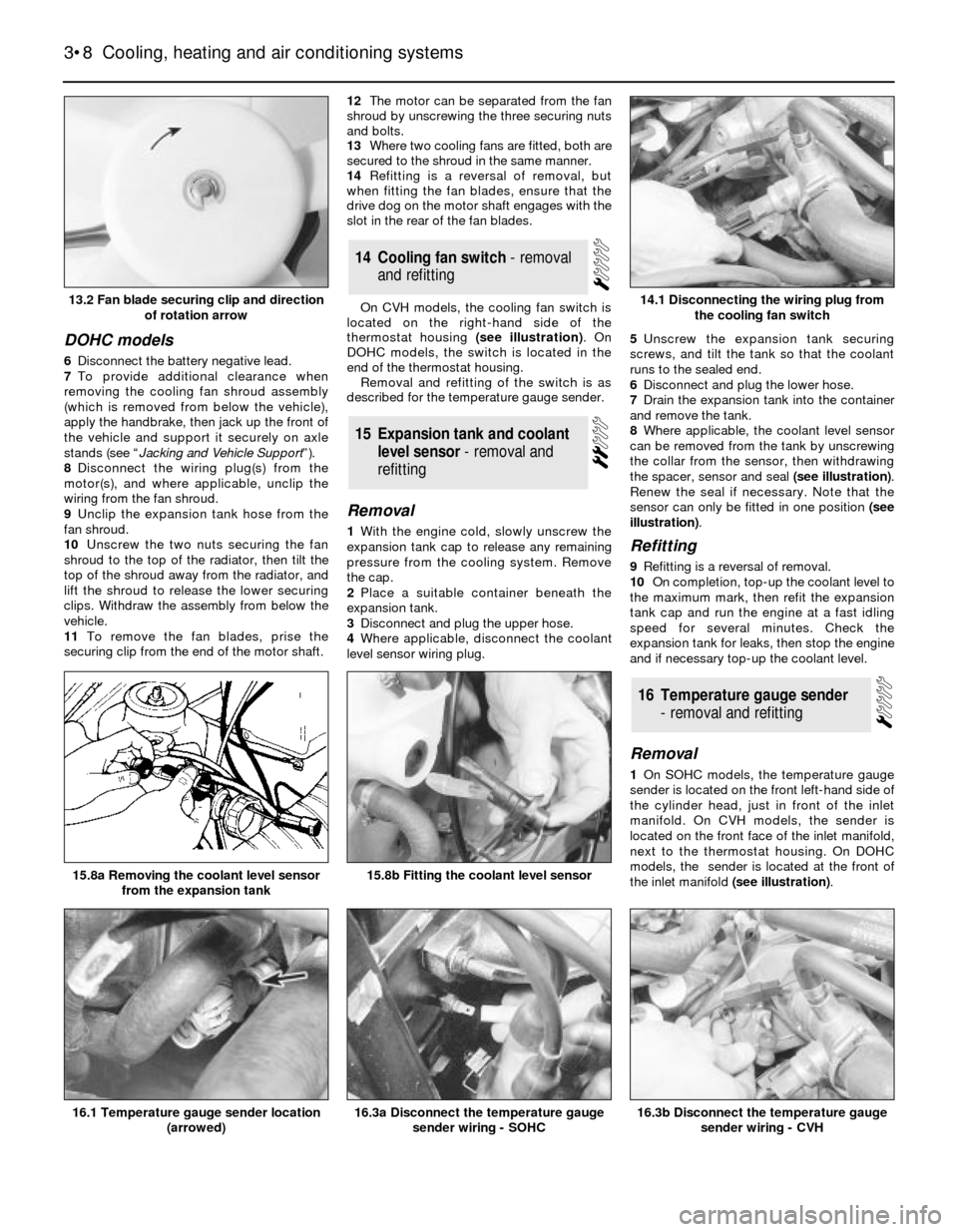
DOHC models
6Disconnect the battery negative lead.
7To provide additional clearance when
removing the cooling fan shroud assembly
(which is removed from below the vehicle),
apply the handbrake, then jack up the front of
the vehicle and support it securely on axle
stands (see “Jacking and Vehicle Support”).
8Disconnect the wiring plug(s) from the
motor(s), and where applicable, unclip the
wiring from the fan shroud.
9Unclip the expansion tank hose from the
fan shroud.
10Unscrew the two nuts securing the fan
shroud to the top of the radiator, then tilt the
top of the shroud away from the radiator, and
lift the shroud to release the lower securing
clips. Withdraw the assembly from below the
vehicle.
11To remove the fan blades, prise the
securing clip from the end of the motor shaft.12The motor can be separated from the fan
shroud by unscrewing the three securing nuts
and bolts.
13Where two cooling fans are fitted, both are
secured to the shroud in the same manner.
14Refitting is a reversal of removal, but
when fitting the fan blades, ensure that the
drive dog on the motor shaft engages with the
slot in the rear of the fan blades.
On CVH models, the cooling fan switch is
located on the right-hand side of the
thermostat housing (see illustration). On
DOHC models, the switch is located in the
end of the thermostat housing.
Removal and refitting of the switch is as
described for the temperature gauge sender.
Removal
1With the engine cold, slowly unscrew the
expansion tank cap to release any remaining
pressure from the cooling system. Remove
the cap.
2Place a suitable container beneath the
expansion tank.
3Disconnect and plug the upper hose.
4Where applicable, disconnect the coolant
level sensor wiring plug. 5Unscrew the expansion tank securing
screws, and tilt the tank so that the coolant
runs to the sealed end.
6Disconnect and plug the lower hose.
7Drain the expansion tank into the container
and remove the tank.
8Where applicable, the coolant level sensor
can be removed from the tank by unscrewing
the collar from the sensor, then withdrawing
the spacer, sensor and seal (see illustration).
Renew the seal if necessary. Note that the
sensor can only be fitted in one position (see
illustration). Refitting
9Refitting is a reversal of removal.
10On completion, top-up the coolant level to
the maximum mark, then refit the expansion
tank cap and run the engine at a fast idling
speed for several minutes. Check the
expansion tank for leaks, then stop the engine
and if necessary top-up the coolant level.
Removal
1On SOHC models, the temperature gauge
sender is located on the front left-hand side of
the cylinder head, just in front of the inlet
manifold. On CVH models, the sender is
located on the front face of the inlet manifold,
next to the thermostat housing. On DOHC
models, the sender is located at the front of
the inlet manifold (see illustration).
16Temperature gauge sender
- removal and refitting
15Expansion tank and coolant
level sensor - removal and
refitting
14Cooling fan switch -removal
andrefitting
3•8Cooling, heating and air conditioning systems
13.2 Fan blade securing clip and direction
of rotation arrow
15.8a Removing the coolant level sensor
from the expansion tank
16.3a Disconnect the temperature gauge
sender wiring - SOHC16.1 Temperature gauge sender location
(arrowed)16.3b Disconnect the temperature gauge
sender wiring - CVH
15.8b Fitting the coolant level sensor
14.1 Disconnecting the wiring plug from
the cooling fan switch
Page 9 of 12
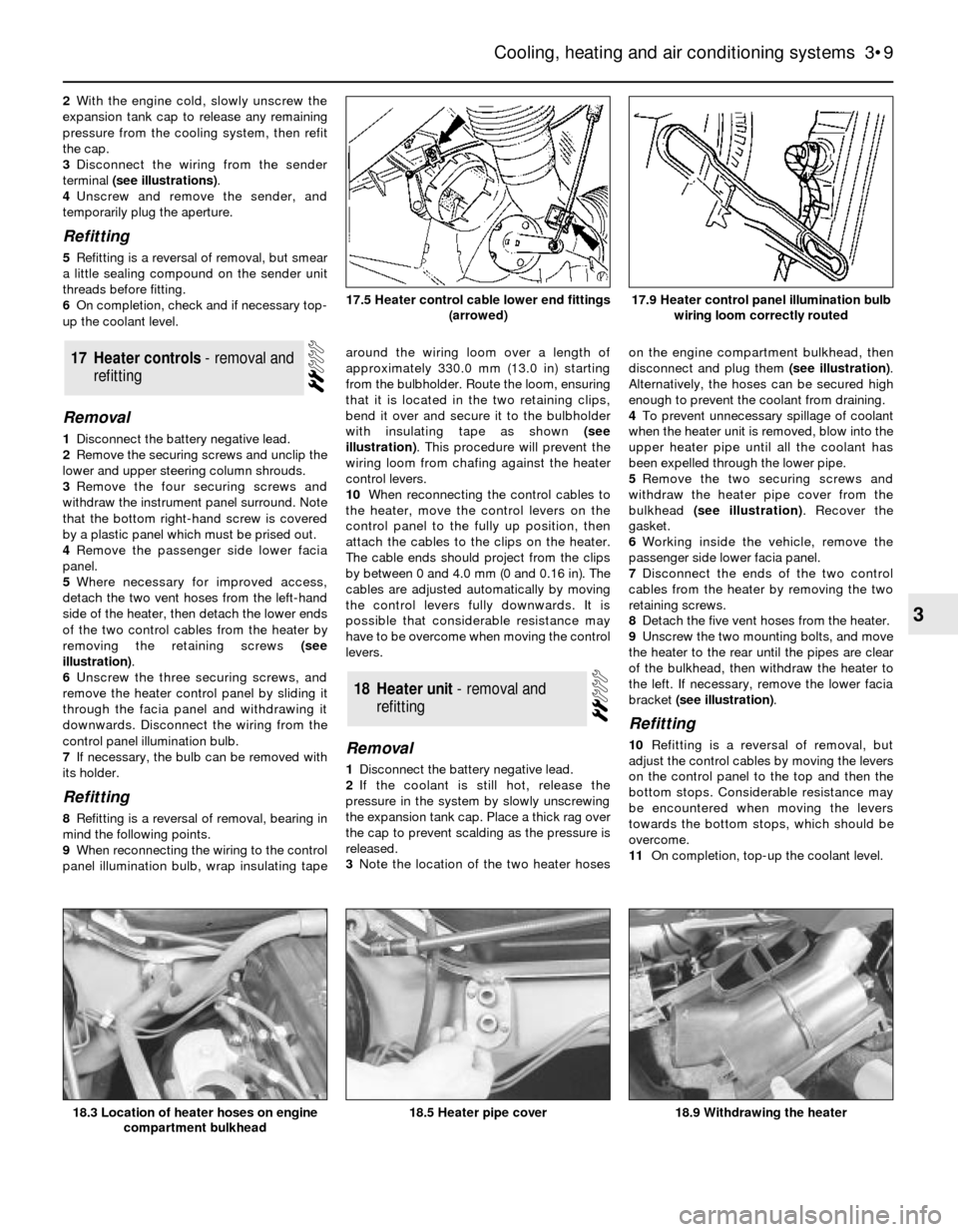
2With the engine cold, slowly unscrew the
expansion tank cap to release any remaining
pressure from the cooling system, then refit
the cap.
3Disconnect the wiring from the sender
terminal (see illustrations).
4Unscrew and remove the sender, and
temporarily plug the aperture.
Refitting
5Refitting is a reversal of removal, but smear
a little sealing compound on the sender unit
threads before fitting.
6On completion, check and if necessary top-
up the coolant level.
Removal
1Disconnect the battery negative lead.
2Remove the securing screws and unclip the
lower and upper steering column shrouds.
3Remove the four securing screws and
withdraw the instrument panel surround. Note
that the bottom right-hand screw is covered
by a plastic panel which must be prised out.
4Remove the passenger side lower facia
panel.
5Where necessary for improved access,
detach the two vent hoses from the left-hand
side of the heater, then detach the lower ends
of the two control cables from the heater by
removing the retaining screws (see
illustration).
6Unscrew the three securing screws, and
remove the heater control panel by sliding it
through the facia panel and withdrawing it
downwards. Disconnect the wiring from the
control panel illumination bulb.
7If necessary, the bulb can be removed with
its holder.
Refitting
8Refitting is a reversal of removal, bearing in
mind the following points.
9When reconnecting the wiring to the control
panel illumination bulb, wrap insulating tapearound the wiring loom over a length of
approximately 330.0 mm (13.0 in) starting
from the bulbholder. Route the loom, ensuring
that it is located in the two retaining clips,
bend it over and secure it to the bulbholder
with insulating tape as shown (see
illustration). This procedure will prevent the
wiring loom from chafing against the heater
control levers.
10When reconnecting the control cables to
the heater, move the control levers on the
control panel to the fully up position, then
attach the cables to the clips on the heater.
The cable ends should project from the clips
by between 0 and 4.0 mm (0 and 0.16 in). The
cables are adjusted automatically by moving
the control levers fully downwards. It is
possible that considerable resistance may
have to be overcome when moving the control
levers.
Removal
1Disconnect the battery negative lead.
2If the coolant is still hot, release the
pressure in the system by slowly unscrewing
the expansion tank cap. Place a thick rag over
the cap to prevent scalding as the pressure is
released.
3Note the location of the two heater hoseson the engine compartment bulkhead, then
disconnect and plug them (see illustration).
Alternatively, the hoses can be secured high
enough to prevent the coolant from draining.
4To prevent unnecessary spillage of coolant
when the heater unit is removed, blow into the
upper heater pipe until all the coolant has
been expelled through the lower pipe.
5Remove the two securing screws and
withdraw the heater pipe cover from the
bulkhead (see illustration). Recover the
gasket.
6Working inside the vehicle, remove the
passenger side lower facia panel.
7Disconnect the ends of the two control
cables from the heater by removing the two
retaining screws.
8Detach the five vent hoses from the heater.
9Unscrew the two mounting bolts, and move
the heater to the rear until the pipes are clear
of the bulkhead, then withdraw the heater to
the left. If necessary, remove the lower facia
bracket (see illustration).
Refitting
10Refitting is a reversal of removal, but
adjust the control cables by moving the levers
on the control panel to the top and then the
bottom stops. Considerable resistance may
be encountered when moving the levers
towards the bottom stops, which should be
overcome.
11On completion, top-up the coolant level.
18Heater unit - removal and
refitting
17Heater controls - removal and
refitting
Cooling, heating and air conditioning systems 3•9
3
18.3 Location of heater hoses on engine
compartment bulkhead18.9 Withdrawing the heater18.5 Heater pipe cover
17.9 Heater control panel illumination bulb
wiring loom correctly routed17.5 Heater control cable lower end fittings
(arrowed)